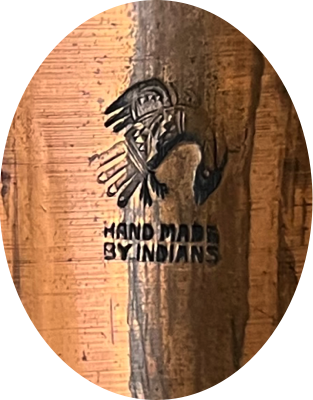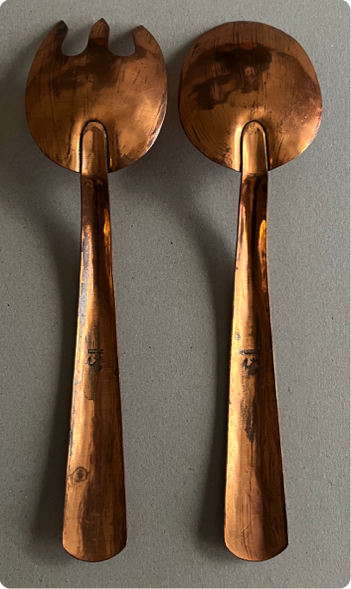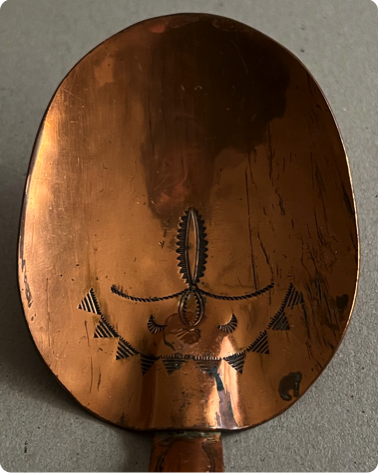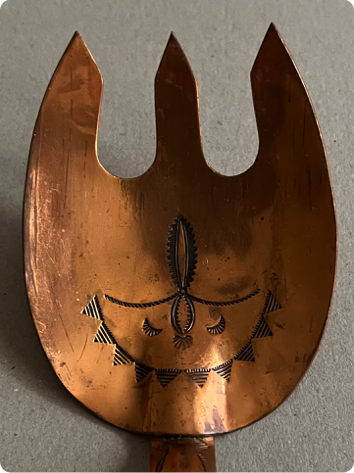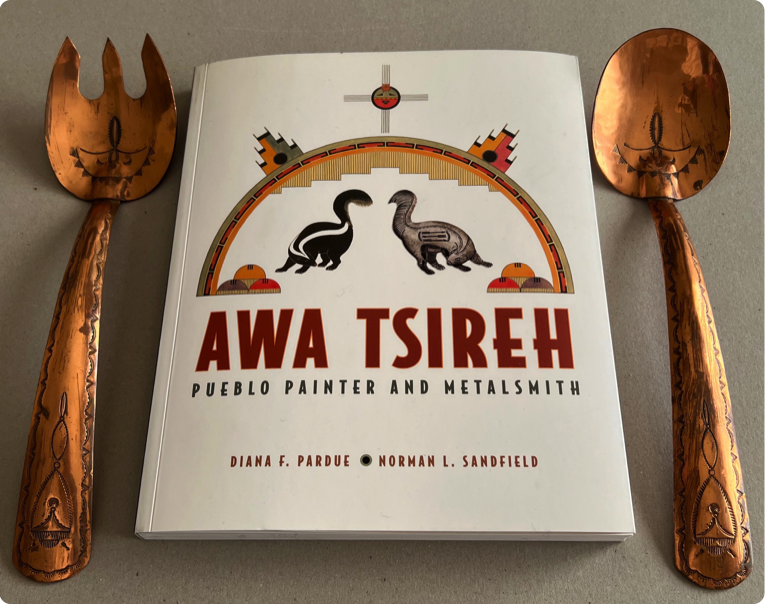
© 2010-2024 by Fine Arts of the Southwest, Inc. All rights reserved.
Unauthorized reproduction or use is strictly prohibited by law.
A very rare and beautiful historic copper serving
set by Awa Tsireh (Alfonso Roybal) for The Garden of the Gods Trading Post, Colorado, c. 1930’s-40’s
For collectors of exceptional Native American jewelry and other fine metalwork and extraordinary Pueblo
paintings, the name "Awa Tsireh" is pure stardust; beauty, magic and mystery rolled into one. His work in both his chosen mediums is absolutely outstanding, rare and extremely coveted by discerning collectors everywhere.
Awa Tsireh (1898-1955), also known by the English translation of his Pueblo Indian name, “cat-tail Bird” and by
his Anglo-American New Mexican name “Alfonso Roybal” was one of the very first Native American artists to achieve widespread public recognition within the realm of the larger American society and at a very tender age. A native
of the northern New Mexico Tewa Indian Pueblo of San Ildefonso, Awa Tsireh came from a prominent family of accomplished artists. His parents were potters as was his sister, Santana Roybal Martinez. Awa Tsireh began his artistic career as a young teenager formally studying painting under the renowned Santa Fe painting instructor, Elizabeth Willis DeHuff (1892-1983). Awa Tsireh was painting seriously before 1917 at only 19 years of age, he was among the very first of the first wave of Native American fine artists in the Southwest in the early 20th Century.
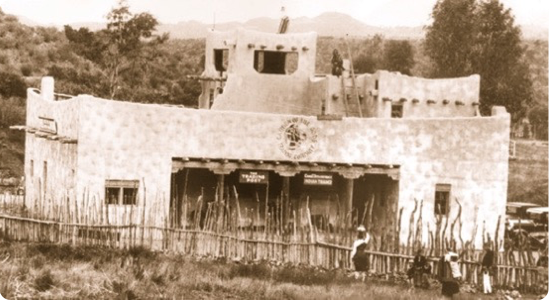
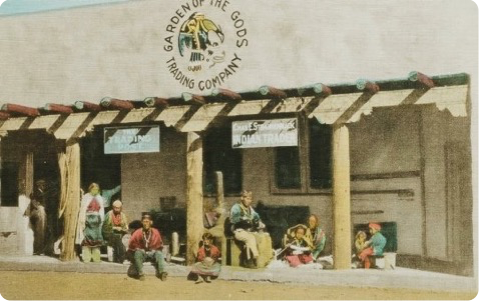
Garden of the Gods Trading Post, Manitou Springs, Colorado, c. 1930.
© Garden of the Gods Trading Company
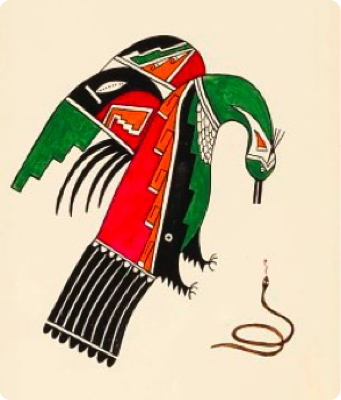

At left and right above are two 1937 watercolor on paper versions of Awa Tsireh’s famous “Cat-Tail” bird namesake insignia and jewelry hallmark. This hallmark was also later used as the logo for The Gardens of the Gods Trading Post. At center, Awa Tsireh’s “Cat-Tail” bird hallmark on the back of this copper serving set.
Awa Tsireh watercolor paintings, Corbin-Henderson Collection, Smithsonian Institution, Washington D.C. Photos © Smithsonian Institution.
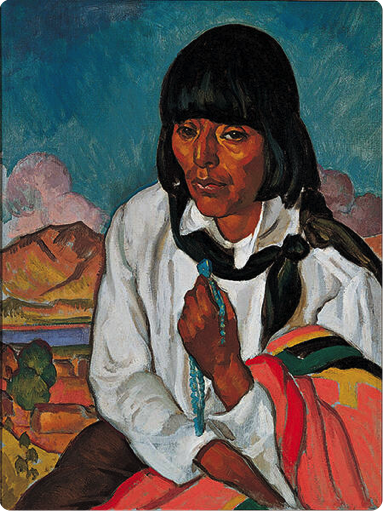
At left, Awa Tsireh at his workbench at The Garden of The Gods Trading Post, c. 1930’s. At right, “Portrait of Awa Tsireh” by William Penhallow Henderson, 1917.
The distinguished Santa Fe Art Colony members, Alice Corbin and William Penhallow Henderson were both close friends of
Awa Tsireh’s and were highly effective supporters, promoters and patrons of his artwork. In 1917, William Penhallow Henderson painted this wonderful portrait of his friend. This panting has a wonderful story. For some time Henderson had been asking
Awa Tsireh to sit for a portrait and Tsireh had never been willing to do so. Suddenly, one day in 1917, Awa Tsireh showed up
at Henderson’s Santa Fe home clad in a fresh, crisp white shirt and said simply “paint me”.
Left photo source and © Heard Museum. Right photo source and © New Mexico Museum of Art, Santa Fe. Gift of Amelia Elizabeth White, 1962.
The beautifully-matched serving set’s large serving spoon and fork are most finely formed and they are gracefully and marvelously decorated along their entire lengths with very finely executed stamp worked designs of Pueblo clouds and rain designs and various panels of meticulously detailed geometric and other ornamental motifs. The overall design composition and execution here is not surprisingly, very “painterly” in its nature and presentation with the copper metal surface of the utensils serving wonderfully as the artist’s “canvas”. Awa Tsireh’s compositions here are complex, layered and ornamental in a decorative presentation style that has come to stylistically be referred to as “Pueblo Deco.”
The two utensils measure a very good-sized 11 1/8" to 11 1/4" in length, and they are about 2 3/4" in width at their widest points. The two pieces together weigh a substantial 321 grams or 8 1/8 ounces just over half a pound of gorgeous pure coppery goodness. Both spoon and fork are in excellent original vintage condition and they are properly and beautifully signed with Awa Tsireh’s customary “Cat-tail bird” hallmark signifying his Tewa Pueblo
Indian name and they are also marked with The Garden of the Gods Trading Post’s well-known Native arts and
crafts motto of “Handmade by Indians.”
The exceptional beauty and startling originality of Awa Tsireh’s early art work caused a sensation in local Santa Fe art circles. Museum of New Mexico Founder and Director, Edgar Lee Hewett (1865-1946) quickly became an enthusiastic and important supporter and provided Awa Tsireh with coveted studio space in Santa Fe’s prestigious Palace of The Governors right next to the studio of another up and coming great Native American Pueblo painter, Hopi Fred Kabotie (1900-1986). Awa Tsireh first became known in the wider American art world when the prominent Santa Fe art authority and poet, Alice Corbin Henderson (1881-1949) and her husband, renowned Santa Fe artist, architect and furniture maker, William Penhallow Henderson (1877-1943) arranged for a major one-man solo exhibition of Awa Tsireh’s watercolors at the prestigious Arts Club of Chicago of whom they were members.
This exhibition was extremely well-received and enthusiastically reviewed. This was an extraordinary, virtually unheard of and very important serious art establishment honor and validation for a 22 year-old Native American artist from a small isolated Indian Pueblo in remote, rural Northern New Mexico especially at that time.
Other important exhibitions of his work in both Chicago and New York and enhanced recognition soon followed and Awa Tsireh’s reputation as a major American artist grew proportionally greater. Today, his work is proudly held in the permanent collections of several prominent museums including The Smithsonian Institution’s American art Museum in Washington D.C. There have also been continued exhibitions of his paintings and metalwork at museums throughout the Southwest. In 2017, The Heard Museum in Phoenix published an excellent book on Awa Tsireh’s work to coincide with the opening of a major exhibition there entitled “Awa Tsireh: Pueblo Painter and Metalsmith."
"What Awa Tsireh did, by his example, among the Pueblos was simply to release a
whole store of latent visual impressions not previously recorded in any purely visual way....[He]first projected the image of this new form of art among the Pueblos."
- Alice Corbin Henderson, "A Boy Painter among the Pueblo Indians." The New York Times, September 6, 1925, Sec. 4, pp. 18-19.
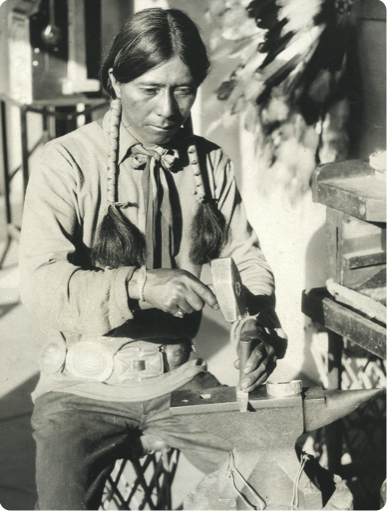
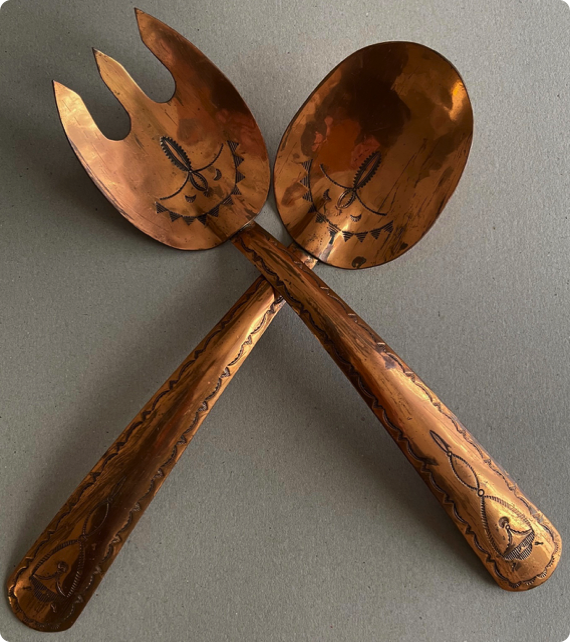
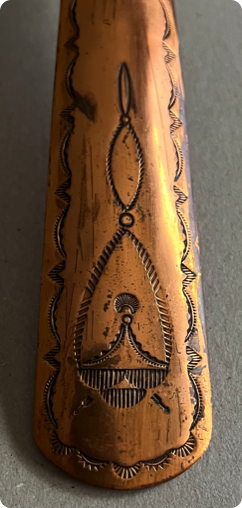
It is somewhat unclear how and by precisely what means Awa Tsireh learned to became so extremely proficient in metalsmithing but he clearly did and by 1930 he was regularly spending summers working as a metalsmith at Charles Strusenbach’s legendary Garden of The Gods Trading Post in Manitou Springs, Colorado, a position he continued to work at seasonally through the 1930’s and 1940’s and where this wonderful copper serving set was created. Trader Strausenbach was a protege of the great Fred Harvey and like his brilliant mentor his vision was to commission and sell only the very finest Native American Arts and Crafts which is why he so carefully courted the presence and prestige of having Awa Tsireh working at his trading post.
In fact, Strausenbach even appropriated Awa Tsireh’s “cat-tail bird” hallmark design to use as the logo of his trading post. At Garden of The Gods, Awa Tsireh made his metal work in a wide variety of metals; copper, silver, brass and aluminum and just as with his painting his metalwork was extraordinarily and unusually accomplished, equally beautiful and visually distinctive, extremely artful and always most finely crafted. Awa Tsireh was a true artistic "polymath" years before that term was ever coined.

This serving set has a fairly interesting provenance, peripherally involving two significant Southwestern museums.
The set was sold around ten years ago at The Wheelwright Museum of Santa Fe’s annual Summer benefit charity auction. The purchaser at the time, from whom we later purchased the set ourselves, was an extremely knowledgable longtime Southwestern scholar and collector who has written several authoritative books in conjunction with and under the auspices of Phoenix’s Heard Museum.
This unique serving set is a very rare and very beautiful example of the very finest work of this very important American and Native American artist. In the course of his lifetime and certainly in the decades since, Awa Tsireh has been treated and regarded and most deservedly so as one of the very first Native American "rockstar" artists. Whether one chooses to actually serve food with these exceptional pieces or to simply display them as the beautiful and fascinating metal sculptural pieces they are, they would be a wonderful, significant and satisfying addition
to any collection of Southwestern Native American art anywhere.
SOLD
